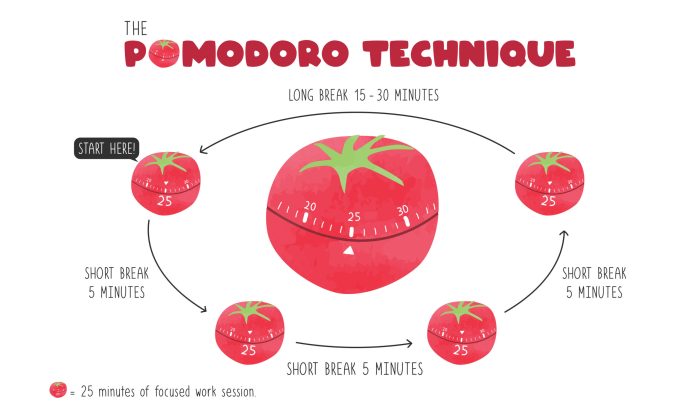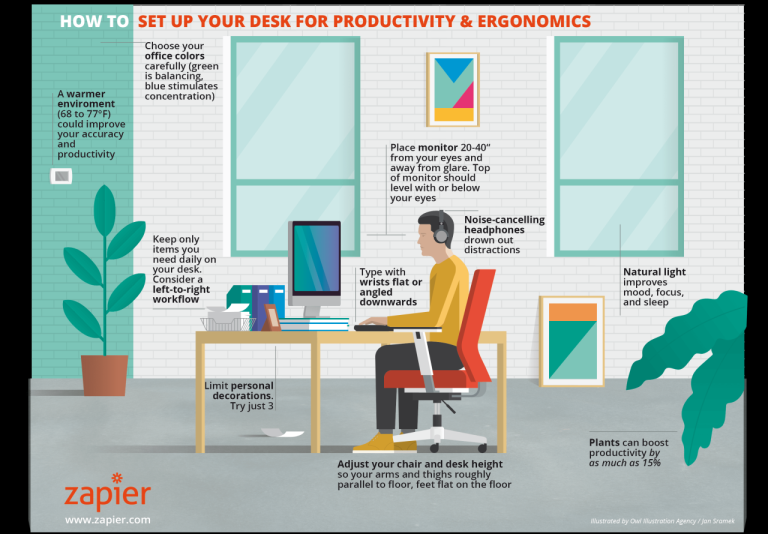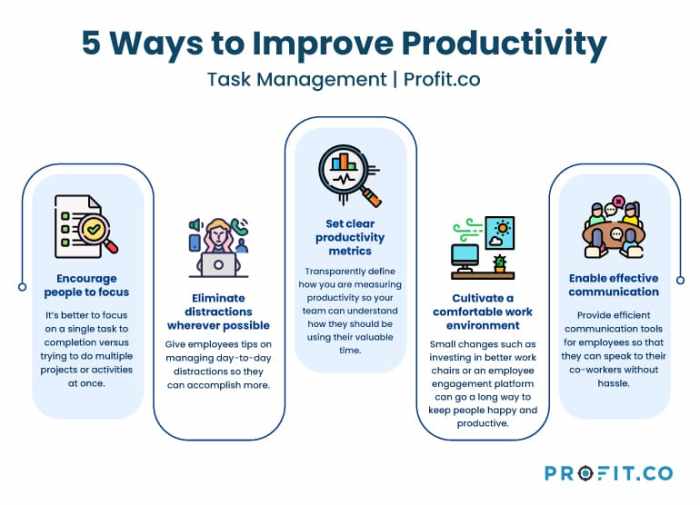
Ever feel overwhelmed by your to-do list? The Pomodoro Technique, a time management method developed by Francesco Cirillo, might be your productivity savior. This simple yet powerful technique uses a timer to break down work into focused intervals, interspersed with short breaks, promoting sustained concentration and reducing mental fatigue.
The Pomodoro Technique’s core principle lies in its cyclical nature. You work on a task for a set amount of time, usually 25 minutes, then take a short break. This cycle is repeated, with longer breaks taken after every four cycles. By adhering to this structured approach, you can effectively manage your time, enhance focus, and achieve more in less time.
Understanding the Pomodoro Technique
The Pomodoro Technique is a time-management method that uses a timer to break down work into intervals, traditionally 25 minutes in length, separated by short breaks. This technique, developed by Francesco Cirillo in the late 1980s, emphasizes focused work sessions followed by brief periods of rest to enhance productivity and combat mental fatigue.
The Core Principles
The Pomodoro Technique operates on the principle of focused work sessions interspersed with short breaks. This approach is designed to maximize productivity by:
- Improving Focus: By setting a timer for a specific duration, the technique encourages focused attention on a single task, minimizing distractions and maximizing output within that timeframe.
- Managing Time Effectively: Breaking down tasks into manageable intervals allows for better time allocation and reduces the feeling of being overwhelmed by large projects.
- Combatting Mental Fatigue: Short breaks between work sessions help to refresh the mind and prevent mental exhaustion, leading to sustained productivity over longer periods.
The History of the Pomodoro Technique
The Pomodoro Technique originated from Francesco Cirillo’s personal struggle with procrastination and time management. He noticed that his study sessions were often interrupted by distractions, leading to decreased productivity. To address this, Cirillo used a kitchen timer shaped like a tomato (Pomodoro in Italian), setting it for 25 minutes to focus on his studies. He followed this with a short break and repeated the cycle.
This method proved effective in improving his focus and productivity, leading to the development of the Pomodoro Technique.
The Scientific Basis
The Pomodoro Technique aligns with scientific research on attention span, focus, and cognitive performance.
- Attention Span: Studies have shown that humans have a limited attention span, typically lasting around 20-25 minutes. The Pomodoro Technique’s 25-minute work intervals align with this research, allowing for focused work before mental fatigue sets in.
- Focus and Cognitive Performance: Research indicates that short breaks can improve cognitive performance and reduce mental fatigue. These breaks allow the brain to rest and process information, leading to enhanced focus and productivity upon returning to work.
Implementing the Pomodoro Technique
The Pomodoro Technique is a time management method that breaks down work into intervals, separated by short breaks. It is a simple yet effective way to improve focus, productivity, and reduce stress. This technique relies on the use of a timer, typically set for 25 minutes, to work on a single task without distractions. Once the timer goes off, you take a short break of 5 minutes, and then repeat the cycle.
Using a Timer
The core of the Pomodoro Technique is the use of a timer. This timer helps you stay focused on the task at hand and track your progress. A timer is used to mark the 25-minute work intervals and the 5-minute breaks.
- Set the timer: Start by setting a timer for 25 minutes. This is the duration of your “Pomodoro” work interval.
- Focus on the task: During this 25-minute interval, concentrate solely on the task you’ve chosen. Minimize distractions and avoid multitasking.
- Take a break: When the timer goes off, take a short 5-minute break. This break allows your mind to rest and recharge.
- Repeat the cycle: After four Pomodoros, take a longer break of 15-30 minutes. This allows for more significant rest and a chance to clear your mind.
Timer Apps and Tools
Numerous timer apps and tools are available to help you implement the Pomodoro Technique. These apps offer various features, such as customizable intervals, break reminders, and progress tracking. Some popular options include:
- Tomato Timer: This simple and user-friendly web app allows you to set the duration of your Pomodoros and breaks, track your progress, and even add notes to each task.
- Focus To-Do: This app combines the Pomodoro Technique with a to-do list, allowing you to manage your tasks and track your progress with the Pomodoro Technique.
- Forest: This app encourages focus by growing a virtual tree while you work. If you leave the app during a Pomodoro, your tree will die.
- Freedom: This app blocks distracting websites and apps for a set amount of time, allowing you to focus on your work without interruption.
Choosing Appropriate Task Durations and Break Lengths
The Pomodoro Technique is flexible and can be adapted to your individual needs and preferences. You can adjust the duration of your Pomodoros and breaks based on your work style and the complexity of the task.
- Complex tasks: If you are working on a complex or challenging task, you may want to shorten your Pomodoros to 20 minutes or even 15 minutes to avoid feeling overwhelmed.
- Simple tasks: For simpler tasks, you can extend your Pomodoros to 30 minutes or even 45 minutes.
- Break lengths: The length of your breaks can also be adjusted. If you find yourself needing more time to recharge, you can extend your breaks to 10 minutes or even 15 minutes.
Optimizing the Pomodoro Technique for Productivity

The Pomodoro Technique is a powerful tool for boosting productivity, but its effectiveness can be significantly enhanced by implementing strategic optimizations. By creating a distraction-free environment, prioritizing tasks, and using breaks strategically, you can maximize your focus and efficiency.
Creating a Distraction-Free Environment
A distraction-free environment is crucial for maximizing the effectiveness of the Pomodoro Technique. Distractions can easily disrupt your focus and derail your progress. Here are some tips for creating a distraction-free workspace:
- Turn off notifications: Disable notifications from your phone, email, and social media accounts. These constant interruptions can easily break your concentration.
- Put your phone away: Place your phone in another room or use a phone app to block distracting apps. Out of sight, out of mind.
- Use noise-canceling headphones: Quiet your environment with noise-canceling headphones or white noise to block out distractions.
- Minimize visual clutter: A clean and organized workspace can help reduce visual distractions and promote a sense of calm.
Prioritizing Tasks
Effective task prioritization is essential for using the Pomodoro Technique to its full potential. It helps you focus on the most important tasks first and avoid getting bogged down in less critical activities.
- Use a to-do list: Create a list of all your tasks and prioritize them based on their importance and urgency.
- Apply the Eisenhower Matrix: The Eisenhower Matrix categorizes tasks based on their urgency and importance, helping you focus on the most critical items.
- Time-block your schedule: Allocate specific time blocks for different tasks, ensuring that you dedicate focused time to your priorities.
Using Breaks Strategically
Breaks are not just time-wasters; they are essential for maintaining focus, boosting creativity, and preventing burnout. Regular breaks help your mind recharge and return to work with renewed energy and clarity.
- Take short breaks: Short breaks of 5-10 minutes every 25 minutes can help you stay refreshed and prevent mental fatigue.
- Engage in physical activity: Take a walk, do some stretching, or engage in light exercise during your breaks to boost your energy levels and clear your mind.
- Step away from screens: Use your breaks to step away from your computer or phone and engage in activities that do not involve screens, such as reading, listening to music, or spending time in nature.
Deep Work and the Pomodoro Technique
“Deep work,” a term coined by Cal Newport, refers to the ability to focus without distraction on cognitively demanding tasks. The Pomodoro Technique can be a powerful tool for achieving deep work by providing a structured framework for focused work sessions.
“Deep work is the ability to focus without distraction on a cognitively demanding task. It’s the single most important skill in our economy.”
Cal Newport
The Pomodoro Technique’s structured work sessions, punctuated by short breaks, create an environment conducive to deep work. By eliminating distractions and committing to focused work blocks, you can enter a state of deep concentration, allowing you to achieve high levels of productivity and output.
The Role of Breaks in the Pomodoro Technique
Breaks are not just optional time-outs in the Pomodoro Technique; they are integral to its success. They are designed to help you maintain focus, prevent burnout, and ultimately enhance your productivity. Think of breaks as strategic pauses that allow your brain to recharge and return to work refreshed and energized.
Types of Breaks
The Pomodoro Technique suggests two primary break types: short breaks and long breaks. These breaks are strategically timed to optimize your mental energy and prevent fatigue.
- Short Breaks: These are 5-minute breaks taken after each 25-minute work session. Short breaks provide a quick opportunity to step away from your task, rest your eyes, and allow your mind to de-stress. They are designed to help you maintain focus and prevent mental fatigue during extended work sessions.
- Long Breaks: After completing four Pomodoro cycles (100 minutes of work), a longer break of 15-20 minutes is recommended. These longer breaks allow for more substantial rest and can be used for activities that help you relax and recharge.
Productive and Restorative Break Activities
The key to maximizing the benefits of breaks is to engage in activities that are both restorative and productive. Here are some ideas:
- Stretching: Simple stretches can help alleviate tension, improve circulation, and boost energy levels.
- Meditation or Mindfulness: Even a few minutes of meditation can help calm your mind, reduce stress, and improve focus.
- Walking: A brisk walk can help clear your head, improve blood flow, and boost your mood.
- Engaging in a Hobby: Spending a few minutes on a hobby you enjoy can help you relax and de-stress.
Benefits of Breaks
Breaks are not just about taking a break; they are a key component of the Pomodoro Technique that can significantly improve your productivity and well-being. Here’s how:
- Enhanced Focus: Regular breaks help prevent mental fatigue, allowing you to return to your work with renewed focus and concentration.
- Reduced Stress: Breaks provide opportunities to de-stress and relax, reducing the risk of burnout and improving your overall well-being.
- Sustainable Work-Life Balance: By incorporating regular breaks into your work schedule, you can create a more sustainable work-life balance, preventing burnout and allowing you to enjoy your personal time more fully.
Adapting the Pomodoro Technique for Different Tasks

The beauty of the Pomodoro Technique lies in its flexibility. While the core principle remains consistent, you can tailor the technique to suit the specific demands of different types of tasks. This adaptability ensures that you can maximize your productivity across a wide range of activities.
Customizing Timer Durations and Break Lengths
The standard 25-minute work interval and 5-minute break might not be ideal for all tasks. Some tasks might require longer focus sessions, while others might benefit from shorter bursts of intense work. Here’s how you can adjust the Pomodoro Technique based on the task at hand:
- Creative Projects: These tasks often require extended periods of focused thought and exploration. Consider increasing the work interval to 30-45 minutes and extending the break to 10-15 minutes to allow for deeper immersion and creative flow.
- Analytical Work: Analytical tasks demand sustained concentration and critical thinking. You can experiment with slightly longer work intervals (30-35 minutes) and shorter breaks (3-5 minutes) to maintain a steady flow of mental energy.
- Routine Tasks: For repetitive or mundane tasks, shorter work intervals (15-20 minutes) and frequent breaks (3-5 minutes) can help maintain focus and prevent boredom. The quick breaks can also provide opportunities to stretch or engage in light physical activity, which can boost energy levels.
Example Pomodoro Settings for Different Task Categories
The following table provides a suggested framework for customizing the Pomodoro Technique based on different task categories:
| Task Category | Work Interval (minutes) | Break Length (minutes) |
|---|---|---|
| Creative Writing | 30-45 | 10-15 |
| Data Analysis | 30-35 | 3-5 |
| Coding | 25-30 | 5-7 |
| Email Management | 15-20 | 3-5 |
| Meeting Preparation | 25-30 | 5-7 |
Productivity Beyond the Pomodoro Technique
While the Pomodoro Technique provides a structured framework for focused work, it’s crucial to understand that it’s just one piece of the productivity puzzle. Optimizing your overall productivity requires a multifaceted approach that encompasses various strategies and techniques.
Time Management Methods
Effective time management plays a pivotal role in achieving optimal productivity. Beyond the Pomodoro Technique, consider incorporating other time management methods into your workflow.
- Time Blocking: Allocate specific time slots in your schedule for different tasks. This approach helps you stay organized and prioritize your workload.
- Eisenhower Matrix: Categorize tasks based on urgency and importance, allowing you to focus on the most critical activities first.
- Getting Things Done (GTD): This method emphasizes capturing, clarifying, organizing, and reviewing tasks to manage your workload effectively.
Goal Setting and Prioritization Techniques
Setting clear goals and prioritizing tasks are essential for maintaining focus and direction.
- SMART Goals: Define goals that are Specific, Measurable, Achievable, Relevant, and Time-bound. This ensures that your goals are clear, actionable, and aligned with your overall objectives.
- Pareto Principle (80/20 Rule): Identify the 20% of tasks that contribute to 80% of your results. Focus on these high-impact activities to maximize your productivity.
- Prioritization Frameworks: Employ frameworks like the MoSCoW method (Must, Should, Could, Won’t) to prioritize tasks based on their importance and feasibility.
Mindfulness and Self-Awareness
Cultivating mindfulness and self-awareness can significantly enhance productivity.
- Mindful Work: Practice being fully present during your work sessions, minimizing distractions and focusing on the task at hand. This improves concentration and reduces stress.
- Self-Reflection: Regularly reflect on your work patterns, identifying areas for improvement and adjusting your strategies accordingly. This helps you optimize your workflow and maximize your efficiency.
- Stress Management: Implement stress management techniques like meditation, deep breathing exercises, or physical activity to maintain focus and reduce mental fatigue.
Resources and Tools
A plethora of resources and tools can support your productivity journey.
- Productivity Apps: Explore apps like Asana, Trello, Todoist, and Notion to organize tasks, track progress, and collaborate with others.
- Time Tracking Software: Tools like Toggl Track, RescueTime, and Clockify help you monitor your time spent on different tasks, identifying areas for improvement.
- Focus-Boosting Apps: Applications like Freedom, Forest, and StayFocusd can block distracting websites and apps, enabling you to maintain focus during work sessions.
- Books on Productivity: Consider reading books like “Getting Things Done” by David Allen, “Atomic Habits” by James Clear, and “Deep Work” by Cal Newport for insights and strategies to enhance your productivity.
The Pomodoro Technique is more than just a time management tool; it’s a mindset shift that encourages mindful work. By embracing its principles, you can cultivate a deeper understanding of your work patterns, optimize your workflow, and ultimately achieve a more balanced and productive life. Whether you’re a student, a professional, or simply looking to improve your personal efficiency, the Pomodoro Technique can be a valuable asset in your journey to achieve your goals.
FAQ Compilation
How long should my Pomodoro intervals be?
The traditional Pomodoro interval is 25 minutes, but you can adjust it based on your preferences and the complexity of your tasks. Experiment with different durations to find what works best for you.
What are some good break activities?
Engage in activities that refresh your mind and body, such as stretching, taking a short walk, listening to music, or meditating. Avoid activities that might distract you from your work, like checking social media or emails.
What if I get interrupted during a Pomodoro?
If you get interrupted, stop the timer and restart it once you’re able to focus again. You can also adjust the length of your Pomodoro interval to accommodate for unexpected interruptions.
Can I use the Pomodoro Technique for creative tasks?
Absolutely! The Pomodoro Technique can be highly effective for creative tasks. It helps you focus on generating ideas, developing concepts, and refining your work in manageable chunks.



